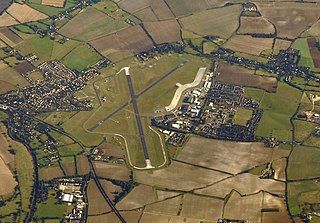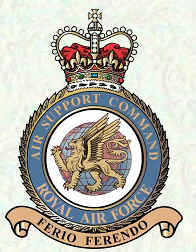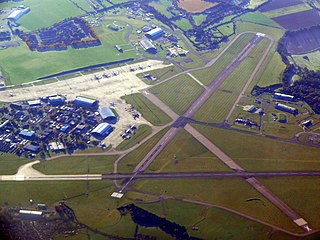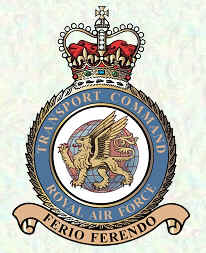
The Desert Air Force (DAF), also known chronologically as Air Headquarters Western Desert, Air Headquarters Libya, the Western Desert Air Force, and the First Tactical Air Force (1TAF), was an Allied tactical air force created from No. 204 Group RAF under RAF Middle East Command in North Africa in 1941 to provide close air support to the British Eighth Army against Axis forces. Throughout the Second World War, the DAF was made up of squadrons from the Royal Air Force (RAF), the South African Air Force (SAAF), the Royal Australian Air Force (RAAF), the United States Army Air Forces (USAAF) and other Allied air forces.

The former Royal Air Force Far East Air Force, more simply known as RAF Far East Air Force, was the Command organisation that controlled all Royal Air Force assets in the east of Asia. It was originally formed as Air Command, South East Asia in 1943 during the Second World War. In 1946, this was renamed RAF Air Command Far East, and finally Far East Air Force in June 1949.

The RAF Second Tactical Air Force (2TAF) was one of three tactical air forces within the Royal Air Force (RAF) during and after the Second World War. It was made up of squadrons and personnel from the RAF, other British Commonwealth air forces, and exiles from German-occupied Europe. Renamed as British Air Forces of Occupation in 1945, 2TAF was recreated in 1951 and became Royal Air Force Germany in 1959.

Royal Air Force Benson or RAF Benson is a Royal Air Force (RAF) station located at Benson, near Wallingford, in South Oxfordshire, England. It is a front-line station and home to the RAF's fleet of Westland Puma HC2 support helicopters, used primarily for the transportation of troops & equipment. Flying squadrons comprise No. 33 Squadron flying the Puma, No. 22 Squadron which provides operational evaluation and training for all aircraft in Joint Helicopter Command and No. 28 Squadron, which is the combined Puma and Boeing Chinook HC6A training unit. Other units include the Oxford University Air Squadron and No. 6 Air Experience Flight, both flying the Grob Tutor T1 light training aircraft used for student and cadet flying training. The National Police Air Service and the Thames Valley Air Ambulance are also based at the station, both operating Airbus H135 helicopters.
RAF Ferry Command was the secretive Royal Air Force command formed on 20 July 1941 to ferry urgently needed aircraft from their place of manufacture in the United States and Canada, to the front line operational units in Britain, Europe, North Africa and the Middle East during the Second World War.

The RAF Third Tactical Air Force, which was formed in South Asia in December 1943, was one of three tactical air forces formed by the Royal Air Force (RAF) during the Second World War. It was made up of squadrons and personnel from the RAF, Indian Air Force (IAF) and the air forces of other Commonwealth countries. Third TAF was formed shortly after the establishment of South East Asia Command to provide close air support to the Fourteenth Army.

Royal Air Force Finningley or RAF Finningley was a Royal Flying Corps and Royal Air Force station at Finningley, in the Metropolitan Borough of Doncaster, South Yorkshire, England. The station straddled the historic county boundaries of both Nottinghamshire and the West Riding of Yorkshire.

No. 3 Group RAF of the Royal Air Force was an RAF group first active in 1918, again between 1923 and 1926, then as part of RAF Bomber Command from 1936 to 1967, and recently part of RAF Strike Command from 2000 until it disbanded on 1 April 2006.

Air Support Command of the Royal Air Force was formed on 1 August 1967 by the redesignation of Transport Command. Its change of name reflected the change of emphasis of the Command from solely transporting materials and manpower around the world to providing general support to RAF operations around the world.

White Waltham Airfield is an operational general aviation aerodrome located at White Waltham, 2 nautical miles southwest of Maidenhead, in the Royal Borough of Windsor and Maidenhead in Berkshire, England.

Royal Air Force Talbenny, or more simply RAF Talbenny, is a former Royal Air Force station located 5.6 miles (9.0 km) north west of Milford Haven, Pembrokeshire and 7.9 miles (12.7 km) south west of Haverfordwest, Pembrokeshire, Wales.

The Royal Air Force Search and Rescue Force was the Royal Air Force organisation which provided around-the-clock aeronautical search and rescue cover in the United Kingdom, Cyprus and the Falkland Islands, from 1986 until 2016.

No. 38 Group RAF was a group of the Royal Air Force which disbanded on 31 December 2020. It was formed on 6 November 1943 from the former 38 Wing with nine squadrons as part of Transport Command. It was disbanded on 31 January 1951, but re-formed on 1 January 1960, became part of RAF Air Support Command in 1967 and then, in 1972, the air support group within RAF Strike Command. It was temporarily disbanded from 18 Nov 1983 to 31 Oct 1992 and from 1 April 2000 to 1 July 2014. It subsequently became part of RAF Air Command, bringing together the Royal Air Force’s Engineering, Logistics, Communications and Medical Operations units. Air Officer Commanding No. 38 Group was also responsible for UK-based United States Visiting Forces (USVF) units and for RAF personnel attached to other global armed forces.

The former Royal Air Force Near East Air Force, more simply known as RAF Near East Air Force, was the Command organisation that controlled all Royal Air Force (RAF) assets in the Eastern Mediterranean.

No. 17 Group RAF was a group of the Royal Air Force which was operational in the last year of the First World War, and throughout the Second World War.

Royal Air Force Lyneham otherwise known as RAF Lyneham was a Royal Air Force station located 6.3 miles (10.1 km) northeast of Chippenham, Wiltshire, and 10.3 miles (16.6 km) southwest of Swindon, Wiltshire, England. The station was the home of all the Lockheed C-130 Hercules transport aircraft of the Royal Air Force (RAF) before they were relocated to RAF Brize Norton.

No. 46 Group RAF was a group of the Royal Air Force.

No. 19 Group was a group of the Royal Air Force, active during 1918, and then from 1941-1969.
RAF India, later called Air Forces in India (1938–47) was a command of the Royal Air Force (RAF) that was active from 1918 until Indian independence and partition in 1947. It was the air force counterpart of the British Army in India.

RAF Iceland is a former Royal Air Force command which controlled RAF units within Iceland. The command was operational between July 1941 and July 1945 during the Second World War, the unit was previously No. 30 Wing RAF.














